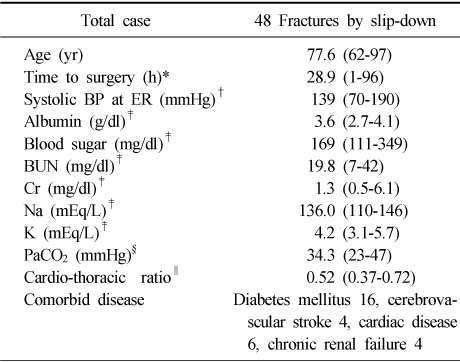Articles
- Page Path
- HOME > J Musculoskelet Trauma > Volume 27(4); 2014 > Article
-
Original Article
- Surgical Fitness for Trochanteric Fracture in Elderly: Prospective Study
- Gu-Hee Jung, M.D., Jong-Seo Lee, M.D., Sung-Gun Heo, M.D., Jae-Do Kim, M.D., Ph.D., Hyun-Ik Cho, M.D.
-
Journal of the Korean Fracture Society 2014;27(4):261-266.
DOI: https://doi.org/10.12671/jkfs.2014.27.4.261
Published online: October 20, 2014
Department of Orthopaedic Surgery, Kosin University College of Medicine, Busan, Korea.
*Department of Orthopaedic Surgery, Gijang Hospital, Busan, Korea.
- Address reprint requests to: Gu-Hee Jung, M.D. Department of Orthopaedic Surgery, Kosin University College of Medicine, 262 Gamcheon-ro, Seo-gu, Busan 602-702, Korea. Tel: 82-51-990-6785, Fax: 82-51-243-0181, jyujin2001@kosin.ac.kr
Copyright © 2014 The Korean Fracture Society. All rights reserved.
This is an Open Access article distributed under the terms of the Creative Commons Attribution Non-Commercial License (http://creativecommons.org/licenses/by-nc/3.0/) which permits unrestricted non-commercial use, distribution, and reproduction in any medium, provided the original work is properly cited.
- 271 Views
- 1 Download
Abstract
-
Purpose
- The purpose of this study was to evaluate the risks of undergoing intramedullary nailing with minimum surgical optimization (fast-track) for geriatric trochanter fracture due to fall from a standing height.
-
Materials and Methods
- From May 2006 to August 2013, 48 fractures were enrolled in fast-track, and were an average age of patients was 77.6 years (range, 62-97 years). They underwent primary testing for anesthesia, including basic body fluid test, arterial blood, electrocardiography, and chest radiographs. The time from visit to surgery was 28.9 hours (range, 1-96 hours).
-
Results
- During hospitalization, there was one case of stress-induced cardiac arrest; however, other complications, infection, and 30-day mortality did not occur. According to preoperative classic test, the average albumin was 3.45 g/dl, blood sugar, 169 mg/dl, blood urea nitrogen, 20.5 mg/dl, Cr, 1.5 mg/dl, Na, 135.3 mEq/L, and K, 4.21 mEq/L. The average PaCO2 of arterial blood was 37.6 mmHg.
-
Conclusion
- We found that the fast-track for trochanteric fracture due to slip-down was relatively safe, and could be considered as a therapeutic approach.
- 1. Clement ND, Aitken SA, Duckworth AD, McQueen MM, Court-Brown CM. The outcome of fractures in very elderly patients. J Bone Joint Surg Br, 2011;93:806-810.ArticlePDF
- 2. Hayes WC, Myers ER, Robinovitch SN, Van Den Kroonenberg A, Courtney AC, McMahon TA. Etiology and prevention of age-related hip fractures. Bone, 1996;18:77S-86S.Article
- 3. Khan SK, Kalra S, Khanna A, Thiruvengada MM, Parker MJ. Timing of surgery for hip fractures: a systematic review of 52 published studies involving 291,413 patients. Injury, 2009;40:692-697.Article
- 4. Davis TR, Sher JL, Porter BB, Checketts RG. The timing of surgery for intertrochanteric femoral fractures. Injury, 1988;19:244-246.Article
- 5. Dorotka R, Schoechtner H, Buchinger W. The influence of immediate surgical treatment of proximal femoral fractures on mortality and quality of life. Operation within six hours of the fracture versus later than six hours. J Bone Joint Surg Br, 2003;85:1107-1113.
- 6. Kenzora JE, McCarthy RE, Lowell JD, Sledge CB. Hip fracture mortality. Relation to age, treatment, preoperative illness, time of surgery, and complications. Clin Orthop Relat Res, 1984;(186):45-56.
- 7. Orosz GM, Magaziner J, Hannan EL, et al. Association of timing of surgery for hip fracture and patient outcomes. JAMA, 2004;291:1738-1743.
- 8. Parker MJ, Pryor GA. The timing of surgery for proximal femoral fractures. J Bone Joint Surg Br, 1992;74:203-205.
- 9. Rogers FB, Shackford SR, Keller MS. Early fixation reduces morbidity and mortality in elderly patients with hip fractures from low-impact falls. J Trauma, 1995;39:261-265.
- 10. Siegmeth AW, Gurusamy K, Parker MJ. Delay to surgery prolongs hospital stay in patients with fractures of the proximal femur. J Bone Joint Surg Br, 2005;87:1123-1126.
- 11. Zuckerman JD, Skovron ML, Koval KJ, Aharonoff G, Frankel VH. Postoperative complications and mortality associated with operative delay in older patients who have a fracture of the hip. J Bone Joint Surg Am, 1995;77:1551-1556.
- 12. American Society of Anestesiologists. New classification of physical status. Anesthesiology, 1963;24:111.
- 13. Marsland D, Colvin PL, Mears SC, Kates SL. How to optimize patients for geriatric fracture surgery. Osteoporos Int, 2010;21:S535-S546.
- 14. Hu F, Jiang C, Shen J, Tang P, Wang Y. Preoperative predictors for mortality following hip fracture surgery: a systematic review and meta-analysis. Injury, 2012;43:676-685.
- 15. Fleisher LA, Beckman JA, Brown KA, et al. ACC/AHA 2007 guidelines on perioperative cardiovascular evaluation and care for noncardiac surgery: executive summary: a report of the American College of Cardiology/American Heart Association Task Force on practice guidelines (writing committee to revise the 2002 guidelines on perioperative cardiovascular evaluation for noncardiac surgery) developed in collaboration with the American Society of Echocardiography, American Society of Nuclear Cardiology, Heart Rhythm Society, Society of Cardiovascular Anesthesiologists, Society for Cardiovascular Angiography and Interventions, Society for Vascular Medicine and Biology, and Society for Vascular Surgery. J Am Coll Cardiol, 2007;50:1707-1732.
- 16. Lane N, Allen K. Hyponatraemia after orthopaedic surgery. BMJ, 1999;318:1363-1364.
- 17. Zakriya KJ, Christmas C, Wenz JF Sr, Franckowiak S, Anderson R, Sieber FE. Preoperative factors associated with postoperative change in confusion assessment method score in hip fracture patients. Anesth Analg, 2002;94:1628-1632. table of contents.
- 18. Lewis JR, Hassan SK, Wenn RT, Moran CG. Mortality and serum urea and electrolytes on admission for hip fracture patients. Injury, 2006;37:698-704.
REFERENCES
Figure & Data
REFERENCES
Citations

Summary of Fast-Tracker
Values are presented as median (range) or number only. *The time from hospital visit to surgery. †Systolic blood pressure at hospital visit. ‡Serum level. §Analysis of arterial blood. ∥Cardiothoracic ratio on chest radiographs. BP: Blood pressure, ER: Emergency room, BUN: Blood urea nitrogen.
Values are presented as median (range) or number only. *The time from hospital visit to surgery. †Systolic blood pressure at hospital visit. ‡Serum level. §Analysis of arterial blood. ∥Cardiothoracic ratio on chest radiographs. BP: Blood pressure, ER: Emergency room, BUN: Blood urea nitrogen.

 E-submission
E-submission KOTA
KOTA TOTA
TOTA TOTS
TOTS

 Cite
Cite

